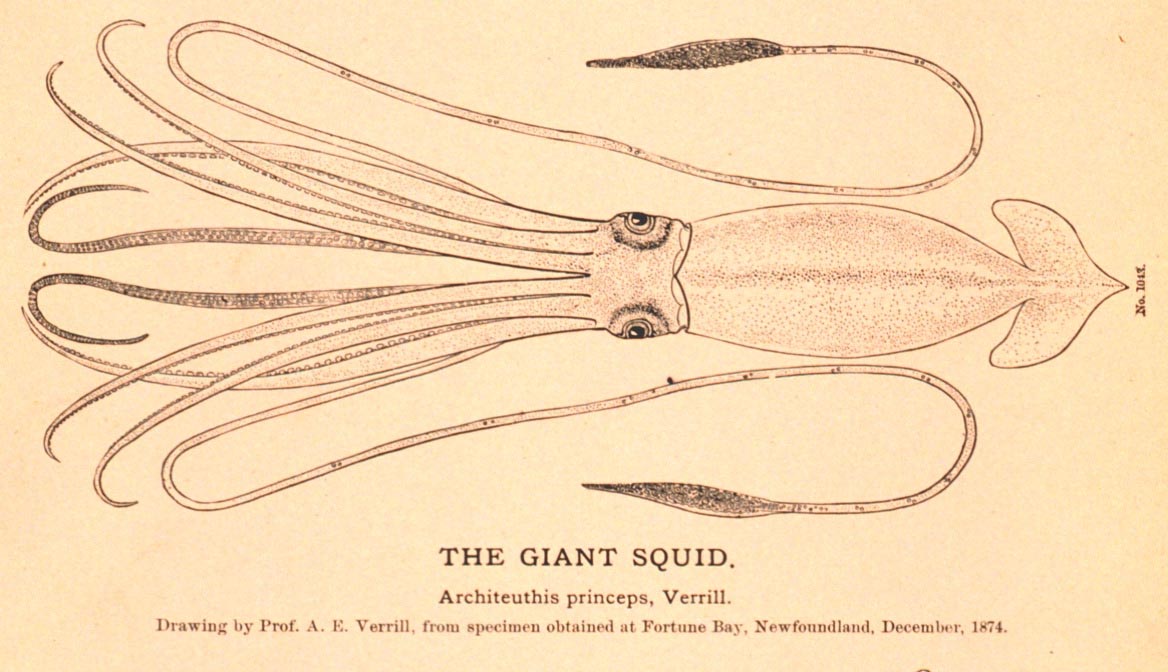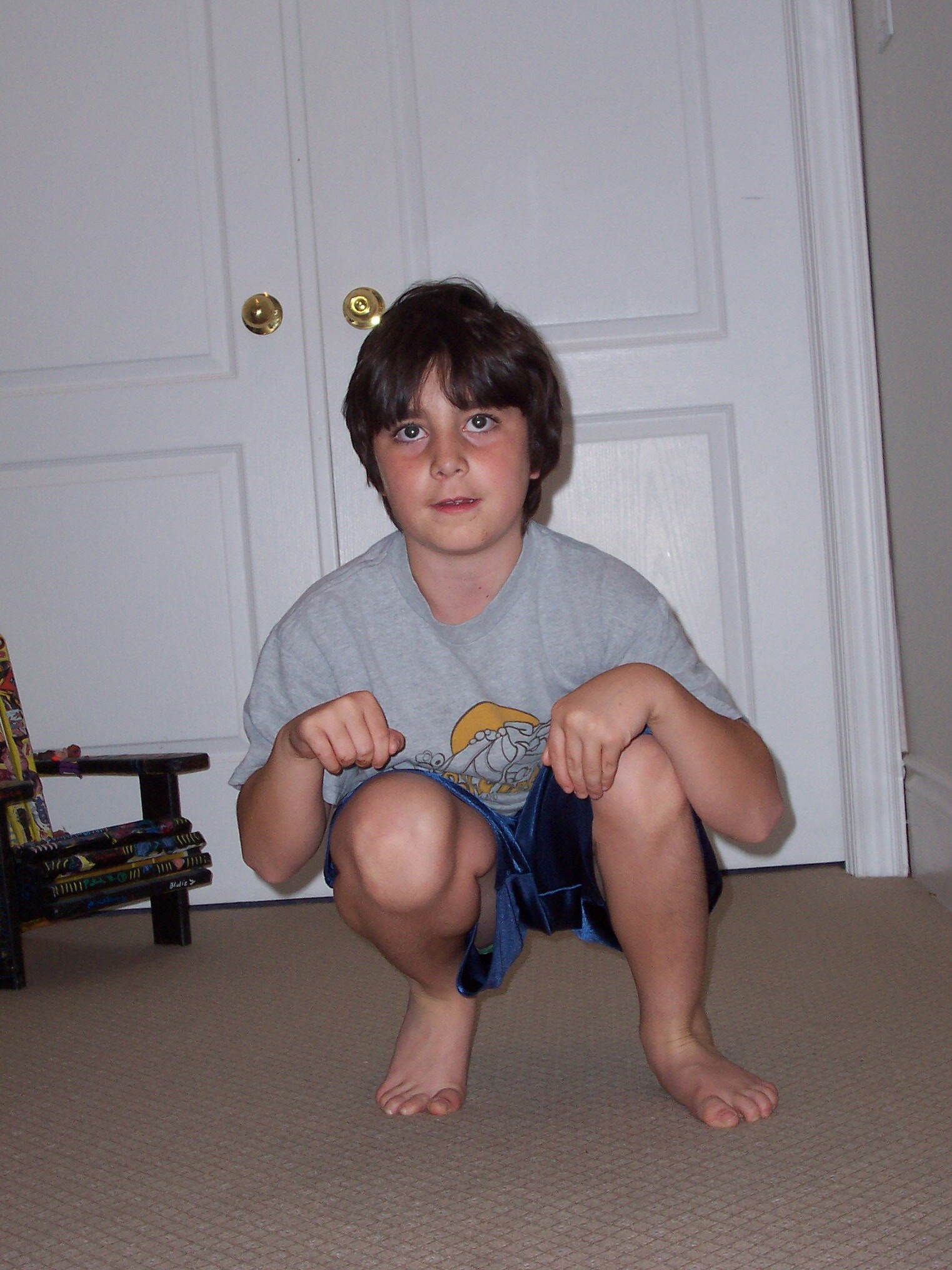Background Information
- The Giant Squid, whose scientific name is Architeutis dux can measure 60 feet or longer in length. Below is a picture of the giant squid.


Architeuthis princeps. Common name, Giant Squid. National Oceanic & Atmospheric Adminstration (NOAA)http://www.photolib.noaa.gov/)
- The Market Squid whose scientific name is Loligo opalescens measures between 8-12 inches in length.
- The Pygmy Squid whose scientific name is Idiosepius pygmaeus measures between 1-2 inches in length.
In the paragraph below, numbers in parentheses refer to the source of the information in the references section.
The squid is an amazing animal, which is unique from other organisms. This is because a squid’s brain and senses are more highly developed than other cephalopods. (2) Unlike other mollusks, squids have the ability to sense and process environmental information. (3) For example, squids can change colour, texture and body patterns extremely quickly in order to camouflage, escape, mate and possibly communicate with one another. (1) They are able to change quickly because they have one big nerve that runs the length of their mantel, making communication between the brain and the pores (which enables the change) faster. (2) In general, another way that squids can escape their predators is by ejecting black ink which confuses the predator and gives the squid a few seconds to camouflage themselves or flee the area. (2) Besides the fact that squids have highly developed brains they also have some physical characteristics that are important. They have human-like eyes which have similar characteristics to those of humans, meaning that they are able to distinguish fine details and have pupils that expand and contract. (1) Squids do not appear to have a shell, however, they have one on the inside, making them similar to other mollusks. (2) Squids can swim up to 20 knots per hour and have been placed in a category of organisms known as Nekton, which are organisms that have developed powers of motion to propel themselves against ocean currents. (1) All squids have ten arms and they use two longer arms called tentacles to eat species of fish, crustaceans, shellfish, and worms because they are carnivores. (1) Squids have three hearts because they need high amounts of oxygen in their blood stream to survive. (1) The characteristics of a squid discussed above are what makes them unique from other organisms.
Squids live in the deep and dark parts of the ocean. The squid’s importance to living in the depths of the ocean is so that the organisms that the squid eats (see paragraph above) do not overpopulate the ocean and cause an imbalance. (1) The adaptations that have taken place so that squids can live in the deep ocean are: they have well developed eyes that detect polarized light and work extremely well in low light conditions; they have accentuated smell, taste and touch senses; and some squids have lost their ink sack and others have developed bioluminescent ink to attract mates, food and to distract predators. (2,3) In conclusion, squids are the type of organism that can be summed up in one small saying, (2) “They live fast and die young.”
The Game
This is a group game best played with an even number of people (odd numbers work too)
- Split the group into two teams of the same size.
- Each group is going to huddle to decide if they want to be a Giant squid, a Pygmy squid, or a Market squid. (This should be done quietly so that the other team does not know what you choose.)
- If the group decides they want to be a Giant squid on the word ‘go’ they will make the Giant squid action (demonstrated in Figure 1). If the group decides they want to be a Pygmy squid they will make the Pygmy squid action (demonstrated in Figure 2) on the word ‘go’. If the decides that they want to be a Market Squid on the word ‘go’ they will make the Market Squid action (demonstrated in Figure 3).
- After each team has decided what type of squid they want to be, they will line up facing each other (one team facing the other team) with about one meter between the two teams.
- On the word ‘go’ (said by the teacher or the person in charge) each team will make the action of the squid that they have chosen.
- Each team should look at the other team’s action to figure out who has won the round. (The Giant squid beats the Market squid because they eat them; the Market squid beats the Pygmy squid because they spray ink at them and then run away; and the Pygmy squid beats the Giant squid because the Pygmy squid can hide in small crevices that the Giant Squid can’t fit into.)
- The loosing team has to turn around and run back to a designated line (about 5-10 meters behind where the team is standing in a line).
- The winning team has to chase after the loosing team and try to tag the people on the loosing team before they cross their designated “safe” line.
- If a member of the loosing team gets tagged they become part of the opposing team.
- Then each team decides on a new action, and the game starts again.
- The game is over when one team has all the players.
- If both teams make the same action on the word ‘go’, the teams huddle together again and decide on a new action.
Information on the Internet
- Squid: The Inside Story This site gives more background information on squids in general.For example you can learn about what a squid eats and how it eats.
- http://www.mbayaq.org/efc/living_species/pnnt.asp?inhab=165 This site gives information specificaly regarding the Market Squid.
- What are Squids? This site shows and explains how squids are classified.It also shows what organisms are similar to the squid, for example cuttlefish.
- Octopuses, Squids and Cuttlefishes This site gives a little bit of information about the Pygmy squid.It also shows pictures of other organisms that are related to the squid such as octopuses and cuttlefishes.
- Squids: The Ultimate in Invertebrate Styling This site gives information mostly on the Giant squid, however, it also gives information such as mating rituals, special adaptations to habitats and myths surrounding the Giant squid.
- The Animal Communication Project This site is an article about how squids communicate. It includes the ideas of scientists who have studied squids and who believe that the way that squids communicate is by the colours and patterns that they make there body.






 Go to quick links
Go to quick search
Go to navigation for this section of the ToL site
Go to detailed links for the ToL site
Go to quick links
Go to quick search
Go to navigation for this section of the ToL site
Go to detailed links for the ToL site